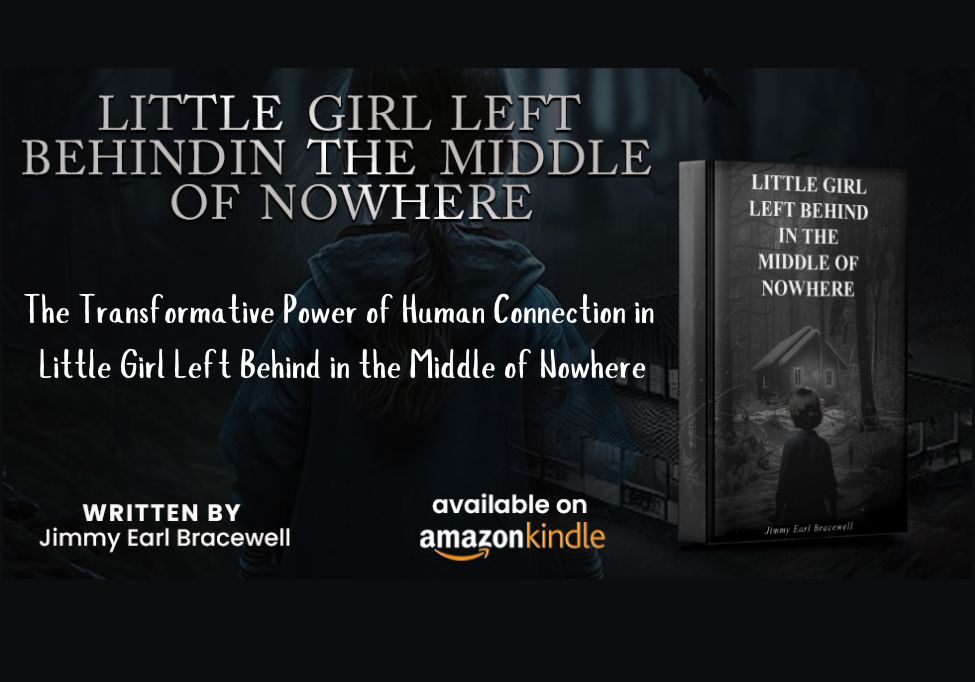Introduction
In Little Girl Left Behind in the Middle of Nowhere, Jimmy Bracewell presents a compelling narrative that explores themes of hope, redemption, and the profound impact of human connection. This novel unfolds a deeply emotional story centered on an extraordinary journey that brings together two unlikely companions. Through its vivid storytelling and heartfelt exploration of resilience and compassion, Bracewell’s book provides a powerful testament to the strength of the human spirit and the unexpected ways in which we find solace and belonging.
Plot Summary and Central Themes
The novel begins with Dave Roberts, a construction worker seeking escape from the relentless noise and stress of city life. His search for tranquility leads him to purchase a remote ranch in a quiet Florida town, where he hopes to find peace and solitude. However, fate intervenes when his car breaks down on a deserted road, leaving him stranded in an unfamiliar and eerie forest. In his search for shelter, Dave stumbles upon a dilapidated shack that becomes the setting for a transformative encounter.
Within the confines of this abandoned structure, Dave discovers Mary Anderson, a twelve-yearold girl who has been abandoned by her neglectful and alcoholic parents. Mary’s heartbreaking situation, marked by abandonment and isolation paints a poignant picture of a young girl clinging to the faint hope that her parents will return. Her vulnerability and desperation evoke a deep sense of empathy, drawing readers into her emotional world.
Moved by Mary’s plight, Dave commits to protect and care for her. As they embark on a challenging journey toward civilization, their relationship evolves, highlighting themes of mutual support and the power of kindness. The narrative showcases their struggles and triumphs, illustrating how acts of compassion can forge unbreakable bonds and transform lives.
Central to the novel are themes of redemption and the redefinition of family. Mary’s journey from an abandoned child to a confident and thriving young cowgirl underscores the novel’s exploration of personal growth and the creation of new familial ties. The story delves into how genuine connections can provide healing and a sense of belonging, even for those who have been cast aside.
Characterization and Development
Bracewell’s characters are crafted with depth and authenticity, bringing the story to life with emotional resonance. Dave Roberts emerges as a figure of empathy and strength, whose initial quest for solitude evolves into a profound commitment to Mary’s well-being. His character arc is pivotal to the narrative, illustrating his growth from a solitary figure seeking escape to a nurturing guardian.
Mary Anderson’s transformation is depicted with emotional sensitivity. From her initial state of fear and abandonment, Mary’s evolution into a resilient and spirited individual highlights the novel’s exploration of personal empowerment and the impact of supportive relationships. Her journey is portrayed with nuance, making her character both relatable and inspiring.
Supporting characters, including Brenda Roberts, Dave’s wife, contribute to the novel’s richness. Brenda’s role in embracing Mary into their family and the development of their relationships add emotional depth to the story. The interactions among these characters emphasize the novel’s themes of familial bonds and the creation of a supportive, makeshift family.
Writing Style and Narrative Structure
Bracewell’s writing in Little Girl Left Behind in the Middle of Nowhere is marked by its evocative and empathetic prose. The author’s descriptive language vividly captures the desolate landscapes and the emotional landscapes of the characters. Bracewell’s attention to detail enriches the reader’s engagement with the story, providing a deep sense of immersion into the characters’ experiences.
The novel’s pacing is thoughtfully managed, balancing moments of introspection with dynamic scenes of action and resolution. This balance keeps readers engaged while allowing for a thorough exploration of the novel’s themes. Bracewell’s narrative structure supports the development of central ideas, ensuring a cohesive and impactful reading experience.
The blend of reflective moments and dramatic events is a notable feature of Bracewell’s storytelling approach. By integrating introspection with unfolding drama, the novel maintains a dynamic flow that enhances the reader’s understanding of the characters’ emotional journeys and the overarching themes.
Critical Reception and Significance
Little Girl Left Behind in the Middle of Nowhere has been praised for its emotional depth and thematic exploration. Critics have lauded Bracewell for crafting a narrative that is both moving and thought-provoking. The novel’s examination of abandonment, redemption, and the formation of new familial connections has resonated with readers, establishing it as a significant contribution to contemporary literature.
The book’s exploration of human connection and personal transformation offers valuable insights into how individuals overcome challenges and form meaningful relationships. Bracewell’s portrayal of these themes provides readers with a rich and impactful experience, contributing to broader discussions about emotional resilience and the power of compassion.
Conclusion
Jimmy Bracewell’s Little Girl Left Behind in the Middle of Nowhere is a poignant and inspiring novel that delves into themes of hope, redemption, and the transformative nature of human connection. Through its rich character development, evocative prose, and insightful exploration of personal growth, Bracewell delivers a story that will resonate with readers long after they turn the final page. This novel is a compelling read for those interested in stories of resilience and the profound impact of unexpected kinship, offering a memorable and engaging experience that captures the essence of the human spirit.





